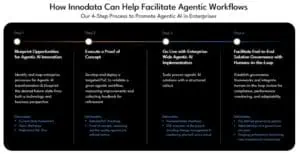How to Design Plan – Act – Observe – Adjust Architectures for Agentic AI
AI is connecting siloed processes and transforming the scope of tomorrow’s economy—one innovation at a time. According to PwC, AI could add $15.7 trillion to the global economy by 2030. Yet many organizations still struggle to turn AI investments into meaningful, enterprise-grade outcomes. The reason? An overreliance on outdated, generic AI models.
Most current systems rely on stateless models—great for fast responses, but inadequate in dynamic, real-world environments. Enterprises need intelligent systems that can plan, act, observe, and adjust autonomously. The answer is implementing Agentic AI and custom architecture to meet your specific requirements.
What is Agentic AI Architecture?
Agentic AI is a system of AI agents that make autonomous decisions through planning, acting, observing results, and adjusting their behavior. These systems use memory, tools, and environmental awareness to operate over multiple steps.
Components of Agentic AI Architecture
- Plan – Act – Observe – Adjust is the core operational cycle of Agentic AI. This closed-loop mechanism gives agents the ability to reason, act, learn from outcomes, and self-correct.
- Memory Systems are short- and long-term memory stores. They enable agents to retain context, learn across sessions, and avoid repetitive or inconsistent outputs.
- Tool Orchestration and Decision Logic Layers manage how agents select and execute tools or APIs to perform complex tasks.
- Governance and Observability Modules provide oversight, ensure compliance, traceability, and support alignment with enterprise policies.
- Data Flow and Integration Principles define how data moves through the system, ensuring consistency, scalability, and secure handling across components.
This architecture allows enterprises to do everything from being sustainable and compliant to implementing multi-step reasoning, transparent decision-making, and real-time adaptability.
Why Custom Agentic AI Architecture is Essential for Enterprise Decision-Making
With custom Agentic AI architecture, enterprises can align AI systems with domain-specific data sources, business logic, and operational workflows. Unlike static, rule-based systems that are siloed and costly to update, Agentic AI architectures are scalable and fully integrated across operations.
Three Core Pillars of Agentic AI: Why Enterprises are implementing GenAI
Pillar 1: Goal-Oriented Autonomy
Agentic Al systems are capable of interpreting a broad, high-level objective provided by a user or enterprise, breaking it down into manageable, actionable sub-tasks. They autonomously design a detailed plan and execute it with minimal to no human intervention, significantly reducing the need for ongoing manual oversight.
The Key Benefit for Enterprises: Operational Scalability & Efficiency
By automating entire business processes from start to finish, Agentic Al allows enterprises to manage complex workloads efficiently. This scalability enables organizations to expand operations seamlessly without requiring a proportional increase in human resources or operational expenses.
Pillar 2: Adaptive Learning & Self-Correction
These intelligent systems continuously ingest and analyze new data streams, enabling them to detect when initial plans are not yielding desired results. They then self-correct by adjusting their strategies and workflows, refining their approach dynamically in real time to enhance performance and ensure better outcomes.
The Key Benefit for Enterprises: Continuous Optimization
Over time, these Al-driven processes continuously improve as the system learns from past experiences and outcomes. This ongoing optimization ensures that business operations remain both efficient and effective, even as market conditions and organizational needs evolve.
Pillar 3: Proactive Contextual Reasoning
Unlike traditional rule-based automation, Agentic Al anticipates future needs and potential risks by leveraging a deep understanding of context. It proactively initiates appropriate actions based on this insight, enabling more nuanced and adaptive
responses to dynamic environments.
The Key Benefit for Enterprises: Enhanced Decision-Making
By integrating advanced perception capabilities, sophisticated reasoning algorithms, and autonomous action-taking, Agentic Al significantly empowers organizations. This integration facilitates faster, smarter, and more resilient decision-making processes that drive improved business performance.
It is easier to plug in proprietary taxonomies, compliance rules, and industry-specific data, and align with each enterprise’s unique objectives.
Case Study: FinRobot, Custom Agentic AI for Enterprise Resource Planning
A recent research study developed a research prototype called FinRobot. It is an agent-based framework designed to explore how Agentic AI concepts can improve enterprise resource planning (ERP) in finance. This was a controlled, academic experiment designed to validate important ideas surrounding the Agentic AI discussion.
The Challenge:
The research highlights that traditional ERP systems typically rely on rigid, rule-based workflows, which struggle to
- Integrate real-time data
- Handle unstructured inputs and
- Adapt to evolving business and regulatory requirements.
Agentic AI Approach:
In this study, FinRobot is designed around a manager agent that interprets high-level tasks and coordinates multiple specialized sub-agents. Each of these agents is responsible for specific functions, like wire transfer processing or employee reimbursements.
These sub-agents operate cross-functionally, adjust their actions based on real-time context, and incorporate generative AI for advanced reasoning and decision-making.
Outcomes of the Study:
- The framework showed a 40% reduction in simulated end-to-end process times.
- It showed a 94% decrease in error rates during task execution.
- Integrated risk checks and continuous monitoring mechanisms improved compliance.
Develop & Deploy Agentic AI Architecture for Your Enterprise: A Practical Guide
To successfully build and deploy Agentic AI from concept to reality, enterprises need to balance technical design with operational governance. This checklist walks you through each phase to break down goals and launch Agentic AI.
1. Hierarchical Planning: Break complex tasks into smaller goals and checkpoints.
Customization: Based on the complexity of a task and your risk appetite, set the enterprise’s goals and choose how often to review the task’s progress.
2. Memory Integration: Use short- and long-term memory to enable continuity and prevent hallucinations.
Customization: Adjust memory windows and integrate with your proprietary data sources like CRMs and document archives to reflect your domain knowledge.
3. Tool Orchestration Optimization: Enable the AI to pick and switch tools or APIs dynamically, optimizing workflows in real time.
Customization: Set performance thresholds and fallback options to ensure every task is completed reliably and efficiently.
4. Observability & Monitoring: Embed real-time telemetry and red teaming to capture inputs, decisions, outputs, and performance metrics. This builds trust and accountability.
Customization: Choose which metrics to track, like latency, error rates, and confidence scores, to define alert rules aligned with your compliance standards.
5. Human-in-the-loop Governance: Design checkpoints, fallback plans, and observability to ensure oversight and alignment.
Customization: Configure approval workflows, audit‑log detail levels, and when to escalate problems to comply with your governance framework.
What Enterprises Often Overlook When Building Custom Agentic AI Architectures
While designing Agentic AI systems, organizations often underestimate some critical integration, operational, and ethical challenges. Addressing these overlooked factors leads to ensuring trust, compliance, and lasting business impact.
- Tool Integration Complexity: Connecting diverse tools and legacy systems can create silos and slow progress. Modular design and clear APIs can help simplify integration, support scaling, and cut maintenance costs.
- Error Handling: Complex, multi-step decision processes introduce potential failure points that can disrupt operations. Embedding retry logic, circuit breakers, and fallback workflows keeps systems resilient and prevents such shortfalls.
- Latency Management: Meeting real-time decision requirements without compromising performance is often underestimated. Optimizing data pipelines and parallelizing tasks helps maintain accuracy and responsiveness.
- Ethical & Regulatory Risks: Enterprises sometimes favor speed and automation and end up overlooking fairness, transparency, and compliance. By integrating bias detection, explainability layers, privacy safeguards, and traceability, organizations can meet strict governance standards.
- Risk of Unsupervised Decision-making: Fully autonomous decisions can introduce hidden risks if left unchecked. Embedding human-in-the-loop checkpoints, escalation paths, and audit trails ensures critical actions remain under control and verifiable.
Build Reliable Agentic AI with Innodata
Agentic AI architectures empower enterprises to shift from static outputs to self-improving systems that plan, act, observe, and adjust. As AI advances, organizations adopting these architectures now will lead with trusted, future-ready intelligence.
Ready to take the next step? Connect with Innodata to design your custom Agentic AI architecture today!

Bring Intelligence to Your Enterprise Processes with Generative AI.
Innodata provides high-quality data solutions for developing industry-leading generative AI models, including diverse golden datasets, fine-tuning data, human preference optimization, red teaming, model safety, and evaluation.

Follow Us


